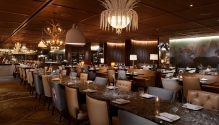Design On The Menu
From the allure of Instagrammable corners to the rise of biophilic and sustainable design, the trends shaping restaurant interiors are as varied as they are influential. Four restaurant design specialists offer insights into the pivotal trends that are reshaping restaurants.
By Rupali Sebastian
As the dining experience continues to evolve, the world of restaurant design has become a dynamic intersection of technology, sustainability, and aesthetic innovation. Interior designers and architects are at the forefront of this transformation, adapting to the changing needs and desires of today’s diners. From the continuing appeal of Instagrammable spaces to the growing influence of sustainability and biophilic design, the trends shaping restaurant interiors are as diverse as they are impactful. Here's a deep dive into the key trends that are defining restaurant design today through the perspectives of four designers—Ameet Mirpuri, Ashiesh Shah, Sumessh Menon, and Shruti Jaipuria—who have shaped some of the most engaging dining spaces in the country.

Sumessh Menon designed La Cena and Takumi as moody, beautifully lit environments.
Form, function…and feeling
According to this panel, crafting a cohesive, soulful environment is key to successful restaurant design, with every element contributing to the guest's emotional journey. While form and function are crucial, says Mirpuri, “creating that feeling is THE most important aspect of designing a restaurant space now.” He believes that the vibe sets the tone for the guest experience and is what keeps them coming back. Shah echoes this sentiment, noting that the emotional impact of a space is as vital as its form and function. He explains, “A well-designed space combines form and function to evoke specific feelings,” using approaches such as Wabi Sabi to create meaningful moments. Jaipuria adds that curating the emotions of a guest is paramount, and that it’s not just about how a space looks but the overall experience. She elaborates, “The lighting, materiality, furniture choice, music, and even waiter uniforms all have to consciously work towards the predesigned experience. Only then is the end product soulful and cohesive.”

Sumessh Founder, Sumessh Menon Associates
Earlier, restaurants had more defined dispositions, now the restraints are more relaxed.
Sumessh Menon
Founder, Sumessh Menon Associates

The role of technology
Technology is no longer just an add-on in restaurant design—it’s an integral part of the experience. Mirpuri emphasises that technology now “rules the entire experience”, from reading menus to controlling lighting and sound. This shift has made it almost impossible to create a functional restaurant space without the integration of advanced tech. “Spatially, curation of lighting, music and other forms of technology have always persisted,” notes Jaipuria. “The use of audio visuals in spaces is also becoming more prevalent.” While she is of the opinion that technology comes to the fore more on the operational front rather than spatial design, Shah states that “advancements in AI are transforming the design process by speeding up production and enabling designers to quickly develop and refine concepts.. This rapid iteration allows designers to stay ahead in a fast-paced industry where trends can shift quickly.

Shruti Jaipuria aimed for a space that exuded both expansiveness and intimacy in Biergarten.
The focus is on the bar and the design is increasingly made more immersive and engaging.
Shruti Jaipuria, Founder, Maia Design Studio


Shruti Jaipuria, Founder, Maia Design Studio.
Instagram’s enduring appeal
Despite the evolving nature of restaurant design, the demand for Instagrammable spaces remains strong, declare all four designers. Menon notes that such spaces are “a major contributing factor to the design of immersive hospitality spatial designs, and there is no going back." He emphasises that “all popular restaurants usually assign a space especially for Insta posts and selfie spots.” Jaipuria echoes this sentiment, stating, “Instagrammable corners are still definitely an ask for clients, whether it's a standalone product or within a hotel space.” Shah ties this enduring requirement to matters of restaurant revenue, saying, “Instagrammable spaces continue to be vital, especially in public areas, as they play a key role in driving a project's economic success by attracting visitors and encouraging repeat visits.”
Acknowledging the trend's persistence, Mirpuri highlights that creating meaningful Instagram-worthy restaurant design takes effort and intentionality, “to not just make it a gimmick and give it some substance.”

Earlier, restaurants had more defined dispositions. Now the restraints are more relaxed.
Instagrammable spaces continue to be vital, especially in public areas, as they play a key role in driving a project's economic success.
Ashiesh Shah
Founder, Ashiesh Shah Architecture + Design

The impact of millennial and gen Z psychographics
“The impact is profound,” says Shah, emphasising that “Millennials and Gen Z crave high-energy spaces that surprise and engage them.” According to him, elements like “kinetic design, digital panels, and strategic lighting” are crucial in creating memorable experiences for this demographic.
Mirpuri and Jaipuria, however, stress the importance of aligning design with the restaurant’s concept and target audience. This approach ensures that the space resonates with its intended audience, whether it’s a high-end fine dining restaurant or a casual café. Mirpuri explains, “If you’re designing a high-end fine dining restaurant, you’re not expecting a young crowd. But innovation is essential. A fresh concept is what drives the guest experience and makes a space memorable.”
Jaipuria agrees, noting, “Restaurant design is fundamentally about storytelling. You need to understand the brand, the product, and the story it wants to tell, and then create a space that brings that narrative to life. Sometimes, a lighter design touch is all that’s needed. Understanding your target clientele is critical before the design process begins, and we always aim to create spaces that are timeless.”

Ashiesh Shah, Founder, Ashiesh Shah Architecture + Design
Instagrammable spaces continue to be vital, especially in public areas, as they play a key role in driving a project's economic success.
Ashiesh Shah
Founder, Ashiesh Shah Architecture + Design


The sensorial Nuema, designed by Ashiesh Shah.
The focus is on the bar and the design is increasingly made more immersive and engaging.
Shruti Jaipuria
Founder, Maia Design Studio

Agile environments
Now the restraints are more relaxed,” with day cafés hosting events, and nightclubs offering early dinner setups and event stages. He emphasises the increasing adaptability in restaurant spaces today. While the designers agree that flexibility and multipurpose design allow modern restaurants to adapt and stay relevant in a competitive market, Jaipuria says, “There is a shifting trend towards smaller, more specialty-driven concepts.” Mirpuri concurs. “With the amount of competition, a lot of spaces have said, ‘we want to stay in our lane and find our niche’, thereby creating restaurants that are single table or smaller spaces that don’t have the size to be flexible!” However, he adds, “Larger restaurants need to be flexible in order to survive, becoming an eatery during the week, a high-energy or performance space over the weekend, or even hosting pop-up markets and bar takeovers.”

Brassa, designed by Jaipuria, is a casual eatery by day and a swanky bar by night.
Bars in the limelight
With the rise of mixology, the bar becomes the pièce de résistance, and “the design is increasingly made more immersive and engaging,” explains Jaipuria. This is achieved by showcasing ingredients, using lower bar counters to connect guests with mixologists, and prominently locating bars within restaurants. The exposure of mixologists' operations, she says, adds a theatrical element, making the experience more engaging. Mirpuri draws attention to the importance of collaboration between mixologists and designers, stating, “Conversations between the mixologist and the designer are more and more important now...they all have their ideas they bring to the table that you have to respect and work together to create something new!” This partnership leads to interactive and collaborative experiences such as bar takeovers. “As a designer, it’s important to showcase the uniqueness of what they come up with!”

Ameet Mirpuri, Founder, Design Studio
Eco-conscious spaces
Given the hospitality industry's significant environmental impact, embracing sustainable strategies is not only a responsible choice but a vital necessity for businesses seeking to minimise their ecological footprint while maximising their positive influence. Mirpuri puts a spotlight on the importance of upcycling and mindful material usage, saying, “We try to use the elements available to us in the space and give them a new and more updated look, thereby also increasing their life span considerably!”
Menon acknowledges that hospitality design is budget-driven but believes sustainable materials and designs can still be incorporated. He notes that the COVID-19 pandemic accelerated the adoption of sustainable design inputs, which have become an enhanced factor in post-pandemic design. Jaipuria observes that while there's growing discussion around sustainability, few projects address it holistically from a carbon neutral or life cycle perspective. However, she notes that designers are increasingly incorporating traditional Indian crafts into spaces, helping to preserve cultural heritage. Jaipuria emphasises, “Collectively, it is very important we start to address [sustainability] holistically.”
The integration of biophilic elements in restaurant design is gaining traction, as designers embrace their potential to foster a connection between nature, architecture, and the human experience. Menon notes that biophilic elements have “seen a considerable rise in the last few years,” driven by factors such as exposure to global design trends and the impact of the pandemic. Mirpuri agrees, noting that COVID-19 heightened the demand for outdoor spaces, leading to an increase in greenery-filled layouts. “More the better,” he says, emphasising that maximalism in greenery can enhance a space. However, Mirpuri cautions that “maintenance is key”, as neglected plants can detract from the overall aesthetic. Jaipuria offers a more critical view, stating, “In theory, definitely people are using the word. In practice, I'm yet to see something well implemented.”
As designers continue to innovate, the dining experience will become increasingly immersive, ensuring that restaurants remain not just places to eat but destinations in their own right.

Crafting a cohesive, soulful environment is key to successful restaurant design.


























